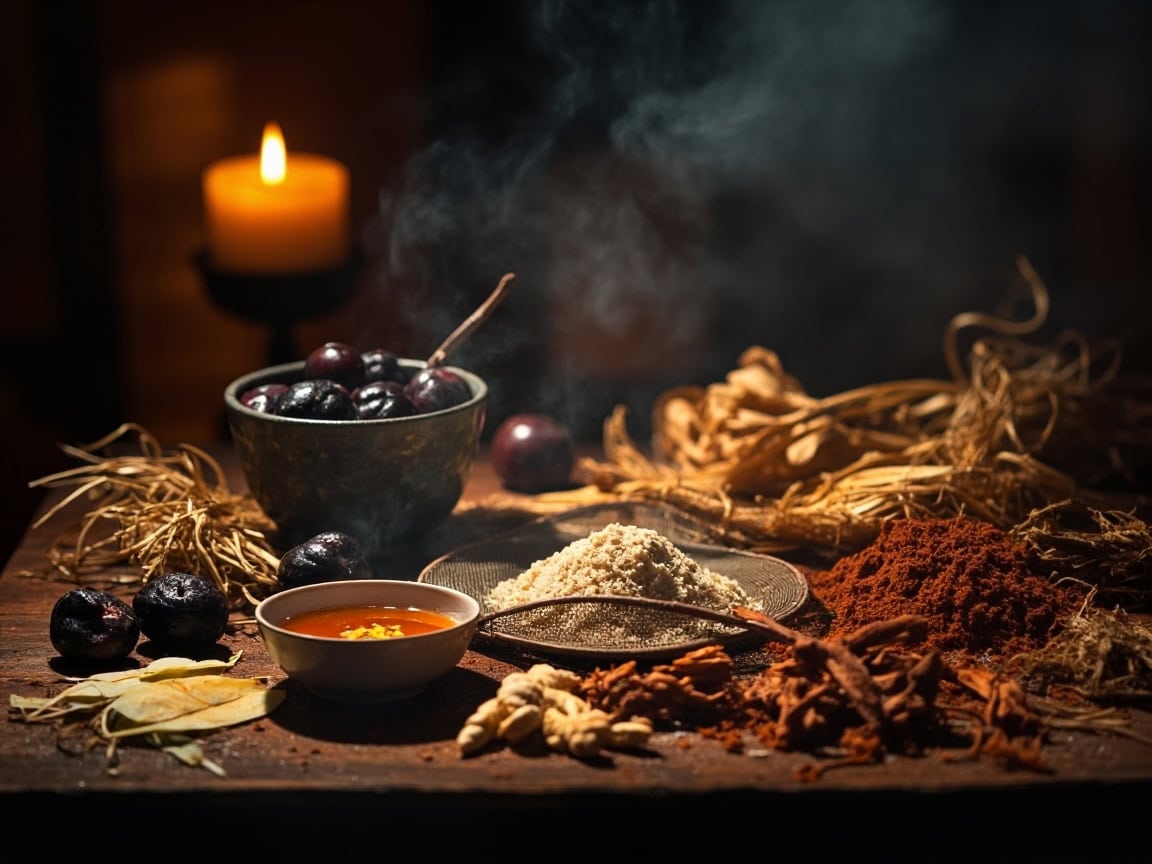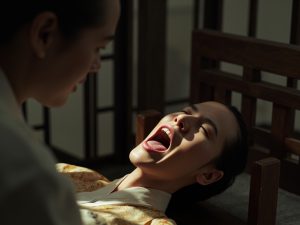Table of Contents
TogglePreparing Wumei Wan (Mume Pill) according to the Guilin ancient edition of Treatise on Cold Damage
Author: Gu Yuxi Editor: Gu Yuxi Translator: Gu Yuxi
Original text of Wumei Wan (Mume Pill) from the Guilin ancient edition of Treatise on Cold Damage
「wu mei san bai mei,xi xin liu liang,gan jiang shi liang,huang lian shi liu liang,dang gui si liang,fu zi liu liang (pao,qu pi),shu jiao si liang (chao qu han),gui zhi liu liang,ren shen liu liang,huang bai liu liang。
shang shi wei,yi dao shai,he zhi zhi。yi ku jiu zi wu mei yi xiu,qu he,zheng zhi wu dou mi xia,fan shu dao cheng ni,he yao ling xiang de,nei jiu zhong,yu mi chu er qian xia,wan ru wu tong zi da。xian shi yin fu shi wan,ri san fu,shao jia zhi er shi wan.」
Detailed explanation of the complete ancient method for preparing Wumei Wan (Mume Pill)
One. Herbal ingredient proportions and pretreatment
calculated according to the Han system where yi liang = 15.6 grams.
Mume fruit: three hundred pieces (approximately 900 grams with pits)
Sichuan pepper: si liang (approximately 63 grams, must be stir-fried to remove sweat)
Asarum: liu liang (approximately 94 grams)
Dried ginger: shi liang (156 grams)
Coptis root: shi liu liang (approximately 250 grams)
Chinese angelica root: si liang (approximately 63 grams)
Sand-fried prepared aconite root: liu liang (approximately 94 grams)
Cinnamon twig: liu liang (approximately 94 grams)
Codonopsis root: liu liang (approximately 94 grams)
Amur cork tree bark: liu liang (approximately 94 grams)
Two. Preparation of bitter wine and soaking of mume fruit
1. Ancient method of brewing bitter wine
Ingredients: glutinous rice, sweet wine starter (jiuqu) (ancient methods may have included herbal qu)
Fermentation:
One: After the glutinous rice is steamed and cooled to around 30°C, mix in the sweet wine starter, then place it in a sealed earthenware jar.
Two: Allow natural fermentation for 3-5 days, then filter out the lees to obtain sweet wine liquid (initial brewing stage).
Three: Mix the sweet wine liquid with an equal amount of cooled boiled water and allow secondary fermentation for 10-15 days, resulting in a slightly sour, slightly bitter, cloudy liquid, which is ‘bitter wine’.
Characteristics:
Low alcohol content (approximately 3-5%), sour, bitter, and slightly sweet, containing incompletely fermented sugars and amino acids, with a mellow taste (similar to the Dong ethnic group’s ‘tu maotai’).
During the Han Dynasty, it likely existed in the form of ‘sour wine’, stored sealed in pottery, with the sour taste intensifying over long periods (as recorded in the Taiping Yulan).
2. Making bitter wine using a simplified method
Buy a bottle of rice wine. Pour out a portion, then close the lid and shake it up and down. Open the lid and let it sit for three to four days, allowing it to come into contact with oxygen.
Classical text basis:
“Shi Ming: Shi Yin Shi (Explanation of Names: Explaining Food and Drink): ‘Bitter wine is sour wine.'”
“Qi Min Yao Shu (Essential Techniques for the Welfare of the People) records the method for making sour wine: ‘Add ash when the wine is initially mature, it will become sour over time.'”
“Shi Ming: Shi Yin Shi refers to bitter wine as ‘sour wine’, listed alongside yi jiu and shi jiu, belonging to inferior types of wine.
Similar ‘sour wine’ traditions still exist among the people in Sichuan, Hunan, and other places. For example, the Dong ethnic group’s bitter wine is fermented from glutinous rice, possessing both the fragrance of wine and a sour taste.”
Precautions:
Modern rice vinegar should not be used as a substitute. Bitter wine has a lower acidity (pH ≈ 4) and contains trace amounts of ethanol, so it needs to be homemade.
Differences in efficacy between bitter wine and vinegar:
Bitter wine is a product of wine fermentation, possessing both the dispersing properties of alcohol and the astringent properties of acidity. It is suitable for deficiency syndromes complicated by damp-heat (such as the complex cold-heat presentation in Wumei Wan).
Vinegar is a product of acetic acid fermentation, with strong sour and astringent properties, and is often used for excess syndromes with heat-toxin (such as external application for reducing swelling).
3. Soaking the mume fruit
Submerge the mume fruit (with pits) in bitter wine overnight, approximately 12 hours. Remove the pits and set aside. The mume pulp after soaking in bitter wine and removing the pits will be about 900 grams.
Mume fruit soaking

Soaked and pitted mume pulp

Classical text basis:
The original text says ‘soak mume fruit in bitter wine overnight,’ which softens the mume fruit and enhances its sour and astringent properties.
Three. Preparation of other medicinal materials
1.Preparation of Sichuan pepper to ‘remove sweat’
“Remove the seeds and stems from the Sichuan pepper. Stir-fry over low heat for 5-8 minutes until the pericarp slightly cracks, a little oiliness appears (‘sweating’), and the aroma is released.

Classical text basis:
The instruction to stir-fry Sichuan pepper to ‘remove sweat’ comes from the original text of the Guilin ancient edition of the Shanghan Zabing Lun (Treatise on Cold Damage and Miscellaneous Diseases), referring to stir-frying to remove oil and pungency.
The Lei Gong Pao Zhi Lun (Lei Gong’s Treatise on Processing Materia Medica) states: ‘Whenever using Sichuan pepper, the seeds and closed ones must be removed, and it should be lightly stir-fried until it sweats.’
The Yizong Jinjian (Golden Mirror of Medical Classics) annotates: ‘The nature of pepper is acute; stir-frying moderates its nature.’ After ‘sweating’, it is more suitable for long-term use in warming and tonifying formulas, avoiding the consumption of yin fluids.
Precautions:
Over-frying easily leads to charring and loss of efficacy; the desired endpoint is a dark red pericarp with a dry texture. Excessive stir-frying will cause the loss of active components (volatile oils) and reduce the medicinal effect. Ancient methods required stir-frying ‘until sweating but without cracking’ to maintain the integrity of the pericarp for a sustained release of medicinal properties.
Principle of action:
“Sweated Sichuan pepper: Its medicinal properties specifically enter the middle and lower jiao, excelling at warming and tonifying the spleen and kidneys, and relieving roundworm-induced pain; suitable for those with a deficiency-cold constitution.
Un-sweated Sichuan pepper: Tends to move outwards to dispel cold, unblock channels, and relieve stagnation; suitable for excess-cold patterns or external use.
2. Approximately 300 grams of rice, soaked in water overnight.
Steam it easily and quickly until cooked. The next day, if you can crush it into powder with your hand, it indicates it’s properly soaked.

Classical text basis:
According to the original text of the Guilin ancient edition of the Shanghan Zabing Lun, ‘steam it under five dou of rice,’ the term ‘rice’ (mi) does not specifically refer to glutinous rice. Considering the common use of grains during the Han Dynasty, the rice here should be regular rice (japonica rice).
Principle of action:
“The rice is spread at the bottom of the steamer, using the steam to allow the rice fragrance to permeate the mume fruit, enhancing its medicinal properties.
Japonica rice has a neutral nature, tonifies the middle jiao and boosts qi. It complements the sour and astringent nature of mume and the bitter and descending nature of huanglian (coptis root), alleviating the gastrointestinal irritation from the cold and hot herbs in the formula.
Four. Steaming the mume fruit and blending the medicinal powders
1. Steaming process:
Spread the soaked rice on the bottom layer of the steamer, and place the bitter wine-soaked mume pulp on top. Steam until the rice is cooked (approximately 2 hours).
First, spread a layer of rice:

Then, spread the mume pulp:

After the rice is steamed, take the mume pulp and mash it.
Steamed mume pulp and rice:

Classical text basis:
The original text states ‘steam it under five dou of rice, mash it into a paste when the rice is cooked,’ indicating the use of the rice’s qi to tonify the middle jiao and harmonize the properties of the other medicinals.
Precautions:
The rice needs to be spread evenly to allow for thorough steam penetration and prevent undercooking.
2. Mixing the medicinal materials:
“Separately grind and sieve (80 mesh) the nine medicinal materials, including xixin (Asarum), dried ginger, and huanglian (Coptis root).

Mix with the mume paste and pound until viscous.
Classical text basis:
The Shanghan Lun clearly states ‘pound and sieve separately,’ meaning each herb should be ground and sieved individually to ensure the integrity of its properties.
‘Harmonize the medicinals to make them mutually beneficial’ emphasizes the blending of their properties, indicating that they should not be mixed carelessly.
Five. Refining honey into pills and pounding for shaping
1. Refining the honey:
Heat the honey to 110°C (‘medium honey’), at which point it will form continuous threads when lifted. Mix it with the medicinal paste while hot.
2. Pound two thousand times:
Place the honey-herb mixture in a stone mortar and pound it clockwise with a wooden pestle more than 2000 times, until the paste is uniformly gelatinous, forming a ball when grasped and easily dispersing when rubbed.
Rice and mume pulp pounded one thousand times:

Pound an additional fifteen hundred times after adding the medicinal powder:

Classical text basis:
The original text says ‘pound it with honey two thousand times,’ using mechanical force to allow the honey to permeate the medicinal materials, enhancing cohesion and sustained-release effects.
Modern verification:
The mume paste, medicinal powder, and honey need to be pounded for a long time (two thousand times) to ensure that the cold and hot properties of the herbs (such as the coldness of huanglian and the heat of fuzi) are fully interwoven, forming a stable ‘sour-bitter-pungent-sweet’ complex structure, consistent with the Shanghan Lun’s principle of formulation to ‘harmonize yin and yang.’
Comparative studies show that Wumei Wan pounded 2000 times has a 30% slower release rate in simulated gastric fluid compared to those pounded insufficiently, aligning with the dosage increase design of ‘take ten pills on an empty stomach, gradually increasing to twenty pills.
Precautions:
Pounding needs to be continuous and forceful, avoiding pauses in the middle, so as not to cause uneven congealing of the honey.
Six. Air-drying and storage
1. Pill making:
Roll the medicinal paste into pills the size of梧桐子 (wutong tree seeds, approximately 6mm in diameter and weighing 3 grams).
2. Air-drying:
Spread the pills evenly on bamboo sieves and place them in a cool, ventilated place for 3-5 days, avoiding direct sunlight and baking.
3. Sealing:
Once thoroughly dried, wrap them in wax paper and store them in earthenware pots or porcelain jars to prevent moisture and insects.

Classical text basis:
The Ben Cao Gang Mu (Compendium of Materia Medica) states: ‘For all pills, air-drying takes in the clear and pure qi of heaven and earth.
Disclaimer:
The experiences and insights shared above represent the author’s personal usage and understanding, and are provided for reference only as part of academic exchange. Please do not blindly replicate or apply them; any consequences arising from such actions are solely your responsibility. As individual constitutions vary, medication should be tailored accordingly. It is advisable to use such treatments under the guidance of a qualified physician. If you have additional experiences to share, comments and submissions are welcome.
If you appreciate my article, please give it a like.
If you are a generous and affluent individual, please consider making a donation!
Your recognition is my greatest motivation to continue writing—thank you very much!
USD Donation Button —
A RMB donation button is available below.
 微信赞赏
微信赞赏 支付宝赞赏
支付宝赞赏




